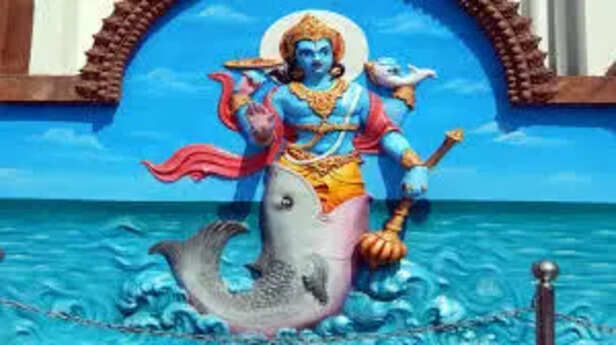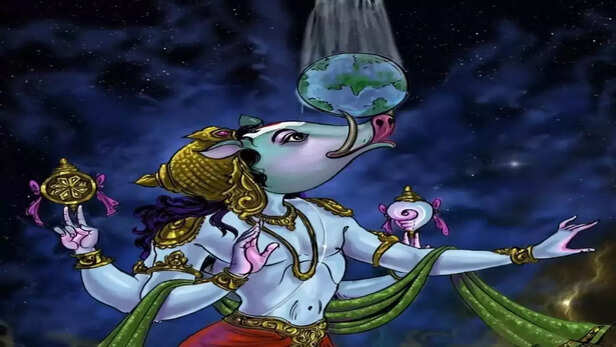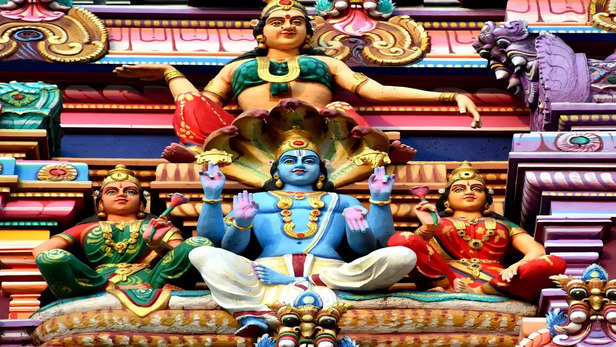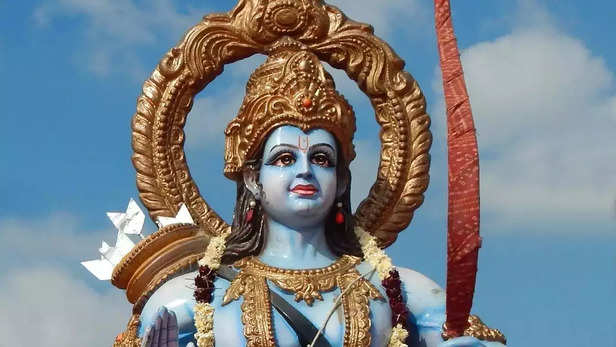What You Never Knew About Vishnu’s 10 Avatars: How These Divine Avatars Changed the Universe!
Shreya | Mar 02, 2025, 21:54 IST
Lord Vishnu.
Vishnu, one of the principal deities in Hinduism, is known for his ten avatars (Dashavatara), each of which played a pivotal role in restoring cosmic balance and protecting the world from chaos. This article delves into each of Vishnu's avatars, exploring how these incarnations not only changed the course of mythology but also left a lasting impact on spiritual and cultural practices across generations.
Vishnu, one of the supreme deities in Hinduism, is known for his role as the protector and preserver of the universe. To maintain cosmic balance and to restore dharma (righteousness), Vishnu incarnates in various forms known as avatars. There are traditionally ten such incarnations, known as the Dashavatara, which are believed to appear in times of crisis, often when the forces of evil outweigh the forces of good.
Each avatar is unique, embodying different qualities, symbolizing the divine intervention needed to restore harmony to the world. These ten avatars form a significant part of Hindu mythology, offering valuable spiritual lessons and marking key turning points in mythological stories.

The first of Vishnu’s avatars is Matsya, a giant fish that appeared to save the sacred scriptures, the Vedas, from the demon Hayagriva, who had stolen them. According to the myth, the world was about to be flooded, and Matsya guided the sage Manu’s boat, which contained the Saptarishi (seven great sages), plants, and animals, to safety.
Impact on
Matsya's incarnation is a symbolic narrative of the preservation of knowledge and wisdom, emphasizing the need to protect sacred teachings in times of turmoil. It also mirrors the theme of survival and renewal, similar to the concept of the Noah’s Ark in Western traditions.

The second avatar of Vishnu is Kurma, a tortoise, which played a crucial role in the churning of the ocean (Samudra Manthan) to obtain the nectar of immortality (amrita). During this churning, the gods and demons used the mountain Mandara as the churning rod, but it began to sink into the ocean. Vishnu incarnated as Kurma to support the mountain on his back and ensure that the churning could continue successfully.
The story of Kurma highlights the importance of support and persistence in overcoming obstacles. It also emphasizes the themes of cooperation, where both gods and demons worked together for a common goal, despite their inherent opposition.

The third avatar is Varaha, a boar that rose from the ocean to rescue the Earth (personified as the goddess Bhudevi) from the demon Hiranyaksha, who had submerged it in the cosmic ocean. Varaha fought the demon and, after defeating him, lifted the Earth on his tusks, restoring it to its rightful place.
Varaha’s story underscores Vishnu's role as the protector of the earth and the sustainer of life. This avatar highlights the power of divine intervention in the restoration of the world and the protection of the natural order against destructive forces.

The fourth avatar, Narasimha, is one of the most dramatic. Vishnu incarnated as a half-man, half-lion to slay the demon Hiranyakashipu, who had been granted a boon that made him invincible to man or beast. Narasimha tore apart the demon with his claws, restoring balance to the universe.
Impact on Mythology
Narasimha’s incarnation demonstrates that divine justice is not bound by the usual laws of nature and that even the most invincible beings are subject to cosmic law. It teaches the concept of absolute power of the divine and the triumph of good over evil, even in the most unusual forms.

The fifth avatar is Vamana, a dwarf Brahmin who visited the demon king Bali, who had conquered the three worlds. Bali offered Vamana three paces of land, and the dwarf, in his third step, grew so large that he covered the entire universe. He pushed Bali down to the underworld, restoring the balance of power between the gods and demons.
Vamana’s avatar highlights humility and the concept that power comes from righteousness, not size or strength. It also illustrates the idea that the divine will always restore balance, even when the forces of evil seem overwhelmingly powerful.

The sixth avatar of Vishnu is Parashurama, a Brahmin warrior armed with an axe. Parashurama incarnated to rid the world of corrupt and tyrannical rulers who had disrupted the balance of dharma. He is often depicted as a fierce warrior who fought against the Kshatriya rulers and restored order to the world.
Parashurama's story emphasizes the need for discipline and justice in society. It teaches that even individuals who belong to peaceful or scholarly traditions can take action to protect dharma when necessary. This avatar also highlights the role of the warrior class in maintaining social order.

Rama, the seventh avatar, is one of the most beloved and revered characters in Hindu mythology. The story of Rama and his wife Sita is told in the epic Ramayana, where Rama, an ideal prince, embarks on a mission to rescue Sita from the demon king Ravana. He is depicted as the epitome of virtue, righteousness, and devotion.
Rama’s avatar represents the ideal of dharma, duty, and moral conduct. The story of Rama teaches the values of loyalty, selflessness, and the importance of fighting for what is right. It has had a profound impact on Hindu culture, setting the standard for ethical behavior.

Krishna, the eighth avatar, is perhaps the most popular and widely worshipped incarnation of Vishnu. His life and teachings are recounted in the Mahabharata, particularly in the Bhagavad Gita, where he imparts spiritual wisdom to the warrior Arjuna on the battlefield of Kurukshetra. Krishna’s playful, mischievous side is also highlighted in stories of his youth, where he is known for his love for Radha and his divine acts.
Krishna's teachings in the Bhagavad Gita are fundamental to Hindu philosophy, focusing on the concepts of karma (action), bhakti (devotion), and dhyana (meditation). His avatar promotes the idea of surrender to the divine will and the pursuit of spiritual enlightenment.

The ninth avatar is Buddha, representing the historical figure Siddhartha Gautama, who founded Buddhism. In this incarnation, Vishnu incarnates to teach compassion and non-violence, guiding individuals toward enlightenment and the cessation of suffering.
Buddha's inclusion in the Dashavatara highlights the fluidity and adaptability of Hinduism, embracing a diverse range of spiritual teachings. It also demonstrates Vishnu’s role in promoting universal values such as peace, non-violence, and inner wisdom.

The tenth and final avatar of Vishnu is Kalki, who is yet to appear. Kalki is prophesied to arrive in the future, riding a white horse, to restore order to the world at the end of the current age (Kali Yuga). Kalki will vanquish the forces of evil and begin a new cycle of creation.
Kalki's avatar represents hope for the future and the restoration of righteousness at the end of a corrupt age. It symbolizes the cyclical nature of time in Hindu cosmology, where creation, preservation, and destruction occur in an eternal rhythm.
Each of Vishnu’s avatars serves a distinct purpose, guiding humanity through periods of crisis, moral challenges, and cosmic imbalance. The stories of these avatars are not just mythological accounts, they are rich with spiritual and ethical lessons that continue to resonate in the lives of millions of Hindus and others worldwide.
Through these incarnations, Vishnu offers not only a framework for understanding the divine but also a blueprint for how individuals can live virtuously, overcome adversity, and find spiritual peace.
Each avatar is unique, embodying different qualities, symbolizing the divine intervention needed to restore harmony to the world. These ten avatars form a significant part of Hindu mythology, offering valuable spiritual lessons and marking key turning points in mythological stories.
1. Matsya

Matsya Avatar.
The first of Vishnu’s avatars is Matsya, a giant fish that appeared to save the sacred scriptures, the Vedas, from the demon Hayagriva, who had stolen them. According to the myth, the world was about to be flooded, and Matsya guided the sage Manu’s boat, which contained the Saptarishi (seven great sages), plants, and animals, to safety.
Impact on Mythology
2. Kurma

Kurma Avatar.
The second avatar of Vishnu is Kurma, a tortoise, which played a crucial role in the churning of the ocean (Samudra Manthan) to obtain the nectar of immortality (amrita). During this churning, the gods and demons used the mountain Mandara as the churning rod, but it began to sink into the ocean. Vishnu incarnated as Kurma to support the mountain on his back and ensure that the churning could continue successfully.
Impact on Mythology
3. Varaha

Varaha Avatar.
The third avatar is Varaha, a boar that rose from the ocean to rescue the Earth (personified as the goddess Bhudevi) from the demon Hiranyaksha, who had submerged it in the cosmic ocean. Varaha fought the demon and, after defeating him, lifted the Earth on his tusks, restoring it to its rightful place.
Impact on Mythology
4. Narasimha

Narasimha Avatar.
The fourth avatar, Narasimha, is one of the most dramatic. Vishnu incarnated as a half-man, half-lion to slay the demon Hiranyakashipu, who had been granted a boon that made him invincible to man or beast. Narasimha tore apart the demon with his claws, restoring balance to the universe.
Impact on Mythology
5. Vamana

Lord Vishnu.
The fifth avatar is Vamana, a dwarf Brahmin who visited the demon king Bali, who had conquered the three worlds. Bali offered Vamana three paces of land, and the dwarf, in his third step, grew so large that he covered the entire universe. He pushed Bali down to the underworld, restoring the balance of power between the gods and demons.
Impact on Mythology
6. Parashurama

Parashurama Avatar.
The sixth avatar of Vishnu is Parashurama, a Brahmin warrior armed with an axe. Parashurama incarnated to rid the world of corrupt and tyrannical rulers who had disrupted the balance of dharma. He is often depicted as a fierce warrior who fought against the Kshatriya rulers and restored order to the world.
Impact on Mythology
7. Rama

Rama Avatar.
Rama, the seventh avatar, is one of the most beloved and revered characters in Hindu mythology. The story of Rama and his wife Sita is told in the epic Ramayana, where Rama, an ideal prince, embarks on a mission to rescue Sita from the demon king Ravana. He is depicted as the epitome of virtue, righteousness, and devotion.
Impact on Mythology
8. Krishna

Krishna Avatar.
Krishna, the eighth avatar, is perhaps the most popular and widely worshipped incarnation of Vishnu. His life and teachings are recounted in the Mahabharata, particularly in the Bhagavad Gita, where he imparts spiritual wisdom to the warrior Arjuna on the battlefield of Kurukshetra. Krishna’s playful, mischievous side is also highlighted in stories of his youth, where he is known for his love for Radha and his divine acts.
Impact on Mythology
9. Buddha

Gautam Buddha.
The ninth avatar is Buddha, representing the historical figure Siddhartha Gautama, who founded Buddhism. In this incarnation, Vishnu incarnates to teach compassion and non-violence, guiding individuals toward enlightenment and the cessation of suffering.
Impact on Mythology
10. Kalki

Amitabh Bachchan in Kalki 2898 AD.
The tenth and final avatar of Vishnu is Kalki, who is yet to appear. Kalki is prophesied to arrive in the future, riding a white horse, to restore order to the world at the end of the current age (Kali Yuga). Kalki will vanquish the forces of evil and begin a new cycle of creation.
Impact on Mythology
Each of Vishnu’s avatars serves a distinct purpose, guiding humanity through periods of crisis, moral challenges, and cosmic imbalance. The stories of these avatars are not just mythological accounts, they are rich with spiritual and ethical lessons that continue to resonate in the lives of millions of Hindus and others worldwide.
Through these incarnations, Vishnu offers not only a framework for understanding the divine but also a blueprint for how individuals can live virtuously, overcome adversity, and find spiritual peace.
